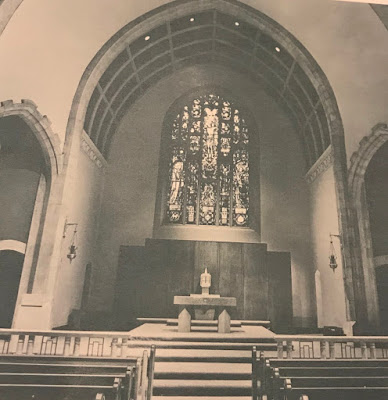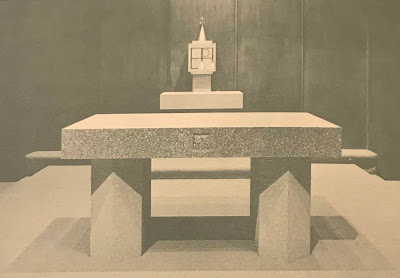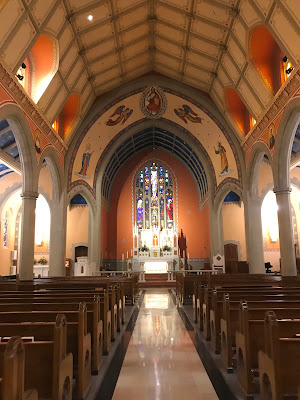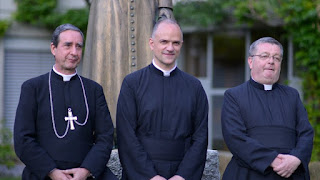By Gregory DiPippo, Editor of The New Liturgical Movement blog. It was a pleasure meeting Gregory very recently while in Rome. We had both attended Sunday Mass at Santissima Trinita Dei Pellegrini, and ran into each other while a group of us were having un caffe e un pannino al aperto at a cafe in the Piazza Della Trinita Dei Pelligrini. It is with pleasure that we post this most recent article from The New Liturgical Movement. Many compliments to Gregory for the hard work he does as editor of this blog. By coincidence, we happen to know the Pastor of Holy Family Parish, Father Daniel Mahoney, V.F.
Holy Family Parish in Latrobe, Pennsylvania, within the Diocese of Greensburg, recently completed a very nice restoration and de-wreckovation. Under the leadership of Fr Daniel Mahoney, V.F., the parish put back the ornately patterned ceiling, a high altar, murals of varies “modern†Saints around the nave, as well as all new lighting and sound system, etc. The decorative work, murals, and painting were done by EverGreene Architectural Arts; the restored churched was blessed with the dedication of the new altar by Bishop Edward Malesic on June 25, 2017. Our thanks to Mr Christopher Pujol, a seminarian of the diocese of Greensburg, for sharing these photos with us, and our congratulations to Fr Mahoney and Bishop Malesic for bringing beauty back to this church. Ad multos annos!
The church prior to the renovations of 1967. Notice the murals, ornamented ceiling, and the similarity to the newly restored high altar seen below. Images of the Holy Family crown the arch.
This is the 1967 renovation of the church as pictured in the commemorative booklet from the consecration; the high altar, pulpit, and all decorative paintings have been removed.
The altar installed in 1967 was granite, and consecrated with the rite in the revised Pontifical of 1961, according to the commemorative booklet of the day. The relic chamber can be seen in the front of the altar where the relics from the original altar were placed; these have now been moved to the new high altar. The booklet from 1967 notes “This restoration observes the prescriptions given in the tradition of the Roman Church, assigning dignity to the altar by due attention to essentials and not to temporary decorations.â€
A more modern photo of the church prior to the restoration of 2017.
The restored church played off the original design by returning the Holy Family to the arch; Christ the Divine Teacher takes the center position, as the parish school is claimed in His name. The focus again becomes the great window of the crucifixion in the apse, as well as the restored high altar with tabernacle.
The new high altar comes from a closed church in the Archdiocese of Baltimore; it is strikingly similar to the original altar of Holy Family. The relics deposited within the mensa are the same from the original high altar.
The beginning of a celebration of Low Mass at the new High Altar, by Fr Daniel Mahoney, assisted by Mr Christopher Pujol, June 2018.

29 June 1988. French Archbp. Marcel Lefebvre consecrated bishops without pontifical mandate. He, thus defied John Paul II who had personally appealed to him, create an ambiguous state for the SSPX which he founded, and incurred with the bishops who participated an excommunication.
This move prompted the creation of the Pontifical Commission “Ecclesia Dei†(where I worked 89-97) as well as the foundation of the Fraternity of St. Peter. Some traditional groups who had been hitherto aligned with the SSPX chose to realign manifestly with the Holy See.
The SSPX insists that they have not separated from Rome.
Over the years, talks between the SSPX and the Holy See have followed a sine wave without resolution. Arcbp. Lefebvre, the great missionary in Africa and Council Father, died in 1991. In 2009 Benedict XVI lifted the 1988 excommunications on the living bishops, though in 2012 one of them was expelled by the SSPX. In 2013, Francis became Pope. Francis said that the priests of the SSPX could validly absolve sins during the 2015 Year of Mercy, which was extended by him thereafter. In 2017, the same Pope said that they could witness marriages, with cooperation of the local diocese.
The SSPX has nearly 700 priests worldwide. My personal meetings with them have been nearly always very positive.
30 years on, there are many issues to work through. The SSPX will soon hold a meeting of their members to determine their near future.
The Superior of the SSPX, one of the bishops consecrated in 1988, H.E. Bernard Fellay, recently gave an interview to the Tagespost.  German HERE. French HERE.
One of the questions that caught my eye involves something that I have wondered about for years.
Why have you not strengthened the ranks of traditionalists within the Church and fought for the truth in unity with Rome?
This is partly due to the history of the French. Since the French Revolution, a good number of French Catholics have been fighting against the error of liberalism. Therefore, events during and after the Council were perceived there much more acutely and urgently than in Germany. It was not about blatant errors, but about trends aiming at opening doors and windows. The reforms which followed showed this more clearly than the Council itself. The problem crystallized with the new mass. In Rome, Archbishop Lefebvre was told: “Either – or. Celebrate the new Mass once, and everything is sorted out.†Our arguments against the new Mass did not matter. The Missal of Paul VI; written in collaboration with Protestant theologians. If one is forced to celebrate this Mass, then there really is a problem. And we were forced.
Here is another interesting bit…
Do you personally trust the Holy Father, Pope Francis?
We have a very good relationship. If we let him know that we are in Rome, his door is open to us. He helps us on a smaller scale. He told us, for example, “I have problems when I do something good for you. I help Protestants and Anglicans, why can not I help Catholics? Some want to prevent an agreement because we are a disruptive element in the Church. The Pope is in between.
(He smiles and shows a handwritten letter that the Holy Father addressed to him in French, which begins with the greeting “Dear brother, dear sonâ€)
I remain astonished at the lack of generosity and charity that the Left – like Beans and Cricket and crew – show toward the SSPX, towards all Catholic tradition, and, apparently, how they hold Pope Francis’ desires for them in contempt.
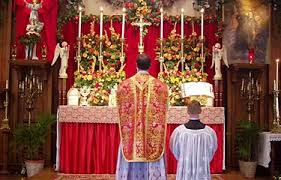
Introit
Apoc 5:9-10
You have redeemed us, O Lord, with Your Blood, out of every tribe and tongue and people and nation, and have made us for our God a kingdom.
Ps 88:2
The favors of the Lord I will sing forever; through all generations my mouth shall proclaim Your faithfulness.
V. Glory be to the Father, and to the Son, and to the Holy Ghost.
R. As it was in the beginning, is now, and ever shall be, world without end. Amen.
You have redeemed us, O Lord, with Your Blood, out of every tribe and tongue and people and nation, and have made us for our God a kingdom.
Collect
The Collects mean the collected prayers of all the faithful assisting at the Holy Sacrifice. Raising his voice, his hands, and his sentiments to God, the priest excites the faithful to unite their prayers with his.
Let us pray.
Almighty, eternal God, Who made Your only-begotten Son the Redeemer of the world, and willed to be reconciled by His Blood, grant us, we beseech You, so to worship in this sacred rite the price of our salvation, and to be so protected by its power against the evils of the present life on earth, that we may enjoy its everlasting fruit in heaven.
Let us pray.
Commemoratio Dominica VI Post Pentecosten
O God of the heavenly powers, creator of all good things, implant in our hearts the love of Your Name, and bestow upon us an increase of godliness, fostering what is good, and, by Your loving care, guarding what You have fostered.
Through Jesus Christ, thy Son our Lord, Who liveth and reigneth with thee, in the unity of the Holy Ghost, ever one God, world without end.
R. Amen.
Lesson
Lesson from the letter of St Paul the Apostle to the Jews
Heb 9:11-15
Brethren: When Christ appeared as High Priest of the good things to come, He entered once for all through the greater and more perfect tabernacle, not made by hands that is, not of this creation, nor again by virtue of blood of goats and calves, but by virtue of His own blood, into the Holies, having obtained eternal redemption. For if the blood of goats and bulls and the sprinkled ashes of a heifer sanctify the unclean unto the cleansing of the flesh, how much more will the blood of Christ, Who through the Holy Spirit offered Himself unblemished unto God, cleanse your conscience from dead works to serve the living God? And this is why He is mediator of a new covenant, that whereas a death has taken place for redemption from the transgressions committed under the former covenant, they who have been called may receive eternal inheritance according to the promise, in Christ Jesus our Lord.
R. Thanks be to God.
Gradual
1 John 5:6-8
This is He Who came in water and in blood, Jesus Christ; not in the water only, but in the water and in the blood.
V. There are three that bear witness in heaven: the Father, the Word, and the Holy Spirit; and these three are one. And there are three that bear witness on earth: the Spirit, the water, and the blood; and these three are one. Alleluia, alleluia.
V. 1 John 5:9 If we receive the testimony of men, the testimony of God is greater.
Gospel
Continuation ☩ of the Holy Gospel according to John
R. Glory be to Thee, O Lord.
John 19:30-35
At that time, when Jesus had taken the wine, He said, It is consummated! And bowing His head, He gave up His spirit. The Jews therefore, since it was the Preparation Day, in order that the bodies might not remain upon the cross on the Sabbath for that Sabbath was a solemn day, besought Pilate that their legs might be broken, and that they might be taken away. The soldiers therefore came and broke the legs of the first, and of the other, who had been crucified with Him. But when they came to Jesus, and saw that He was already dead, they did not break His legs; but one of the soldiers opened His side with a lance, and immediately there came out Blood and water. And he who saw it has borne witness, and his witness is true.
R. Praise be to Thee, O Christ.
Offertory
1 Cor. 10:16
The Cup of blessing that we bless, is it not the sharing of the Blood of Christ? And the Bread that we break, is it not the partaking of the Body of the Lord?
Secret
Through this divine rite, we beseech You, may we draw near to Jesus, the mediator of the new covenant, and renew upon Your altar, O Lord of hosts, the sprinkling of blood more eloquent than that of Abel.
Through the same Jesus Christ, thy Son, Our Lord, Who liveth and reigneth with thee in the unity of the Holy Ghost, God, world without end.
R. Amen.
Commemoratio Dominica VI Post Pentecosten
Mercifully hear our humble prayers, O Lord, and graciously accept these offerings of Your people, and grant that no prayer may be without effect, no petition in vain, so that what we ask in faith, we may really obtain.
Through Jesus Christ, thy Son our Lord, Who liveth and reigneth with thee, in the unity of the Holy Ghost, ever one God, world without end.
R. Amen.
Communion
Heb 9:28
Christ was offered once to take away the sins of many; the second time with no part in sin He will appear unto the salvation of those who await Him.
Post Communion
Admitted to the sacred banquet, O Lord, we have drawn water in joy from the Savior’s fountain; may His Blood, we beseech You, become for us a fountain of water springing up unto life everlasting.
Who livest and reignest with God the Father, in the unity of the Holy Spirit, one God, world without end.
R. Amen
Let us pray.
Commemoratio Dominica VI Post Pentecosten
We have been filled with Your gifts, O Lord; grant, we beseech You, that we may be cleansed and strengthened by their effect.
Through Jesus Christ, thy Son our Lord, Who liveth and reigneth with thee, in the unity of the Holy Ghost, ever one God, world without end.
R. Amen.
From acatholiclife.blogspot.com
Today, according to the Traditional Catholic Calendars of 1962 and previous, is the Feast of the Most Precious Blood of Our Lord Jesus Christ. After Vatican II, this feast day was combined with Corpus Christi. In the 1969 Calendar, Corpus Christi is officially called the Solemnity of the Body and Blood of Christ. However, for those Catholics who like to follow the Traditional Calendar, today is a day to especially remember the price of our salvation – the Blood of Jesus Christ. Today we remember His blood spilt not only on the Cross but also in the Circumcision, Agony in the Garden of Gethsemane, Scourging at the Pillar of Flagellation, and the Crowning with Thorns.
This feast was instituted in 1849 by Pope Pius IX and was raised to the rank of a double of the first class by Pius XI on the occasion of the nineteenth centenary of our Savior’s death.
We are reminded of the scene of Calvary and of the blow from the lance which pierced our Savior’s side. The liturgy today is at pains to emphasize the meaning and tremendous significance of this fact in relation with our salvation. The Gospel and the Epistle are concerned with our Redemption, effected by the Blood and the love of our Savior.
God so loved the world that He gave His only begotten Son. The Son’s love was so great that He gave His very life. No greater love is there than to give one’s very life for the ones that he loves.
Not only did our Lord sacrifice His very life, but He so arranged that this sacrifice would continue to the end of time. He daily offers Himself up in an un-bloody manner in the Sacrifice of the Mass.
Here upon the holy altar Our Lord makes Himself present under the appearances of bread and wine through the miracle of transubstantiation. Here too the sacrifice is complete. Christ is made present and then destroyed for our salvation.
St. Paul to the Corinthians says: “The chalice of benediction which we bless, is it not the communion of the blood of Christ? And the bread which we break, is it not the partaking of the body of the Lord?”
We were not present to witness the awesome bloody sacrifice of God in atonement for our sins. We did not stand beneath the cross to receive the last drops of His precious blood upon our souls. Yet, we are still able to receive these same graces. We are able to follow our Lord spiritually to Calvary every time we assist at Mass.
It took great courage, conviction, and even more so, love to follow our Lord to Calvary. There were not many who had this love, conviction or courage. The majority of the Apostles were found wanting in this area. They had much to fear from a worldly point of view. They did not wish to receive the same fate as their Master. We have a much easier path to follow. Our Lord remains hidden, but is present nonetheless. He invites us to participate in this sacrifice, and we now have nothing to fear from the world. Perhaps the worst that we will receive today from the world is mockery, ridicule and scorn; but even this is rare in the worldly indifference of today.
Not only is our path easier to follow because we do not have to fear the physical persecution of the world, but it is also much more intimate. In the Sacrifice of the Mass we are able to unite our sacrifices with Christ’s and we are able to receive Him into our own bodies and souls.
He comes to us the living Christ (Body, Blood, Soul and Divinity). He comes to us in a manner that will not frighten or shock us, hidden under the appearance of bread and wine. He makes Himself very docile to us and allows us not only to approach Him, but even to consume Him. In this manner we are able to unite ourselves with Him, and He with us.
This is the most precious time — the time of Communion. The all powerful and all merciful God becomes the guest of our very bodies and souls. Here is the point where Heaven and earth meet, and all that is in disorder is easily righted.
Christ is truly our guest, but we are the beneficiaries of His benevolence. He wishes for us to receive Him so that He may give to us. The words of St. Francis ring most truly in Holy Communion: “It is in giving that we receive.”
May we truly realize the words from today’s Post-communion: “We have been admitted, Lord to the Holy Table, and we have drawn water with joy from the fountains of the Savior; may His Blood be for us, we pray, a fountain of water springing up to eternal life. Who being God lives and reigns.”
Prayer:
Almighty and everlasting God, Who didst appoint Thine only-begotten Son to be Redeemer of the world, and dist vouchsafe to be appeased by His Blood: grant, we beseech Thee, that (by our solemn service), we may so venerate the Price of our redemption, and by its power be so defended from the evils of this present life on earth, that we may enjoy its fruit for evermore in heaven. Through the same our Lord.


